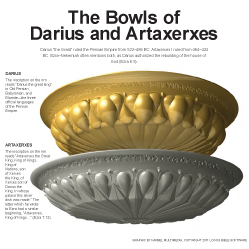1:1–3 In the Hebrew Bible, the books of Nehemiah |
1:1 The words of Nehemiah While statements attributing the words of a book to a particular person are unusual in Hebrew narrative, they are common in prophetic books (see Jer 1:1; Amos 1:1).
Nehemiah Means “Yahweh comforts”; the name comes from the same root word as the name Nahum, meaning “comfort.” Nehemiah’s father’s name is mentioned to distinguish him from other individuals named Nehemiah (Ezra 2:2; Neh 3:16; 7:7).
the month of Kislev Corresponds to November or December. The ninth month of the Jewish calendar. Hanani likely planned his trip to Judah with the intention of returning to Susa before the onset of winter.
 Israelite Calendar Table
Israelite Calendar Table
 Calendars in Old Testament Times
Calendars in Old Testament Times
the twentieth year The twentieth year of the reign of Artaxerxes was 445 bc. See note on Neh 2:1.
1:2 Hanani A shortened form of Hananiah, which means “Yahweh has been gracious.” Hanani is mentioned again in Neh 7:2.
one of my brothers While the Hebrew term used here could refer broadly to a kinsman, Hanani may be a biological brother of Nehemiah.
had escaped the captivity Refers to those Jews who returned to Jerusalem following the Babylonian exile, which ended ca. 538 bc.
1:3 the province Refers to the province of the Trans-Euphrates (or “Beyond the River”), of which Judah was a part. See note on Ezra 4:10.
The wall of Jerusalem is broken down More than 90 years had passed since Cyrus’ decree allowing Jews to return to Jerusalem in 538 bc. A number of factors probably led to the failure of the returned exiles to rebuild the city during this time, including fear of enemies (Ezra 4:1–4; Neh 4–6) and the denial of permission earlier in Artaxerxes’ reign (see Ezra 4:7–23). In addition, they may have had misplaced priorities, as happened earlier in the case of rebuilding the temple (Hag 1). If the Jews were reluctant to rebuild the temple, they may also have been reluctant to rebuild the city.
1:4–11 This is the first of 12 prayers recorded in the book. The prayer is in the form of an inclusio, which occurs when similar or identical phrases, motifs, or episodes begin and end a literary unit. The words of Nehemiah’s prayer are an allusion to Deut 30:1–4. At times, Nehemiah paraphrases the text; at other times he directly quotes it. |
1:4 I sat A customary posture during mourning and fasting (Ezra 9:3; Job 2:8, 13).
mourned Nehemiah’s mourning likely went on for four months—until the events of Neh 2.
1:5 great and awesome These words were originally used to describe Yahweh in Deut 7:21. Nehemiah also uses them in Neh 4:14 and 9:32.
the ones who love him and for those who keep his commands A reference to Exod 20:6 and Deut 5:10. Daniel uses this same phraseology to begin his prayer concerning the 70 years of captivity predicted by Jeremiah (Dan 9:4).
covenant and loyal love Linking covenant with chesed—the Hebrew word for Yahweh’s covenant love—suggests that Yahweh would honor the covenant He made with His people because of His loyal love.
 Chesed Word Study
Chesed Word Study
1:6 your eyes open to hear the prayer of Nehemiah uses these figures of speech to indicate that he wanted Yahweh to answer his prayer. The use of “eyes open” in reference to God’s listening to prayer is also found in 1 Kgs 8:52.
your servant The Hebrew word used here appears eight times in this prayer to refer to Nehemiah himself, Moses, or the people of Israel in general.
by day and by night Nehemiah uttered this prayer on a regular basis for the four months between the report of Hanani and the cupbearer’s opportunity to make his request of the king.
1:7 the commands, regulations, and judgments Nehemiah uses three different Hebrew terms synonymously to refer to God’s law. The variation and repetition is similar to that of psalms praising the Law like Psalm 19 or Psalm 119 (compare Psa 19:7–9).
your servant Moses Nehemiah is referring to the entirety of the law of Moses.
1:9 the place Refers to the city of Jerusalem (Deut 12:5, 11; 1 Kgs 11:13).
(Deut 12:5, 11; 1 Kgs 11:13).
1:10 you have redeemed The Hebrew term for “to redeem” refers to paying to liberate a person from slavery—a ransom.
by your strong hand Alludes to Exod 32:11 and other passages (see Deut 7:8; 9:26) where the same phrases are used in reference to Yahweh’s redemption of the nation from Egypt.
1:11 this man Refers to the Persian king, Artaxerxes. As the king’s cupbearer, Nehemiah would ordinarily use a title of honor and respect for his king. Nehemiah may use this phrase to emphasize that the powerful Persian king was a mere man in comparison to Nehemiah’s God.
As the king’s cupbearer, Nehemiah would ordinarily use a title of honor and respect for his king. Nehemiah may use this phrase to emphasize that the powerful Persian king was a mere man in comparison to Nehemiah’s God.
cupbearer for the king An important occupation in the ancient Near East (see note on Gen 40:1). Nehemiah’s occupation as cupbearer demonstrates that he was already a person of impeccable character with excellent administrative skill.
demonstrates that he was already a person of impeccable character with excellent administrative skill.

|
About Faithlife Study BibleFaithlife Study Bible (FSB) is your guide to the ancient world of the Old and New Testaments, with study notes and articles that draw from a wide range of academic research. FSB helps you learn how to think about interpretation methods and issues so that you can gain a deeper understanding of the text. |
| Copyright |
Copyright 2012 Logos Bible Software. |
| Support Info | fsb |
 Loading…
Loading…


